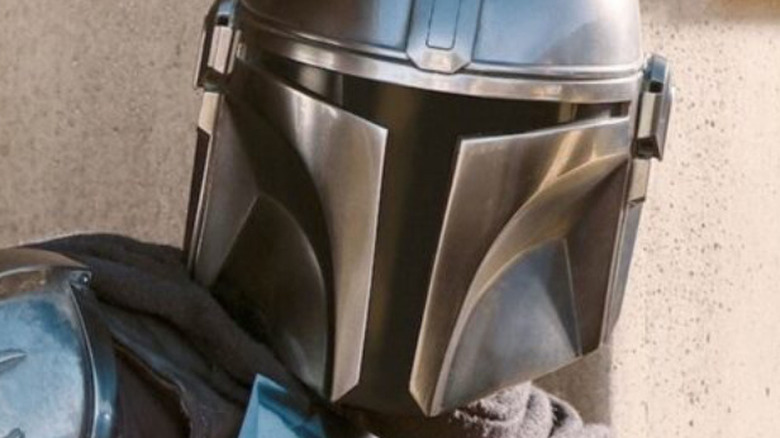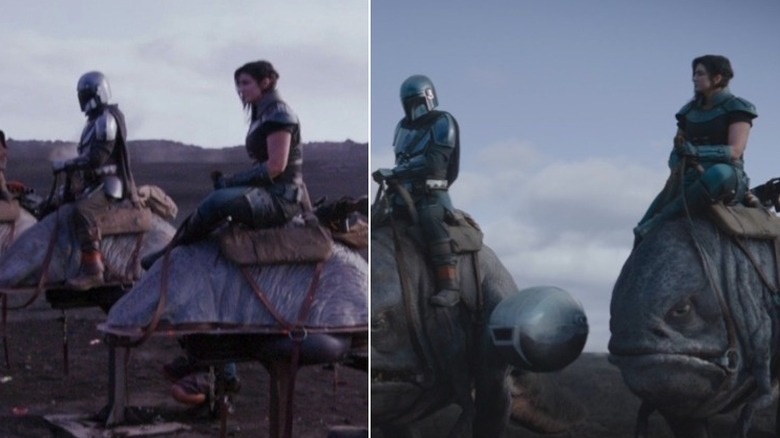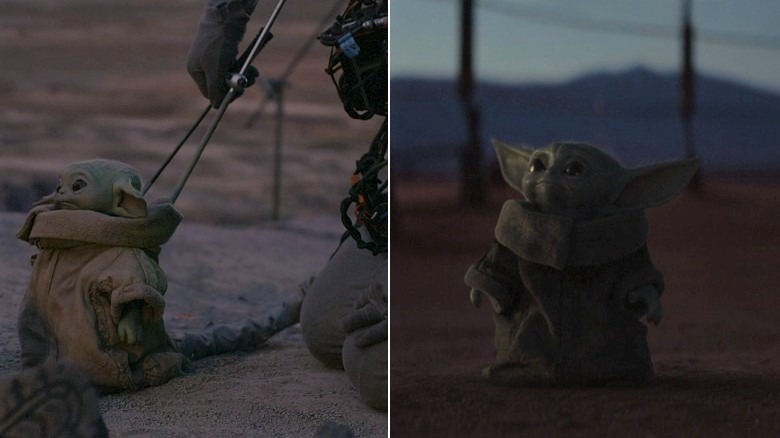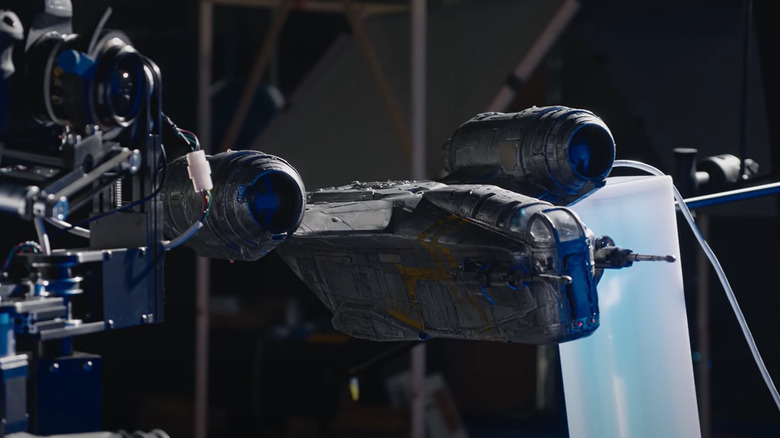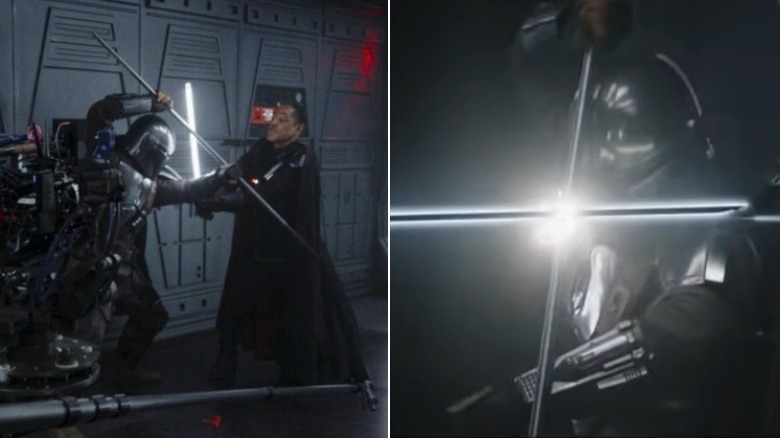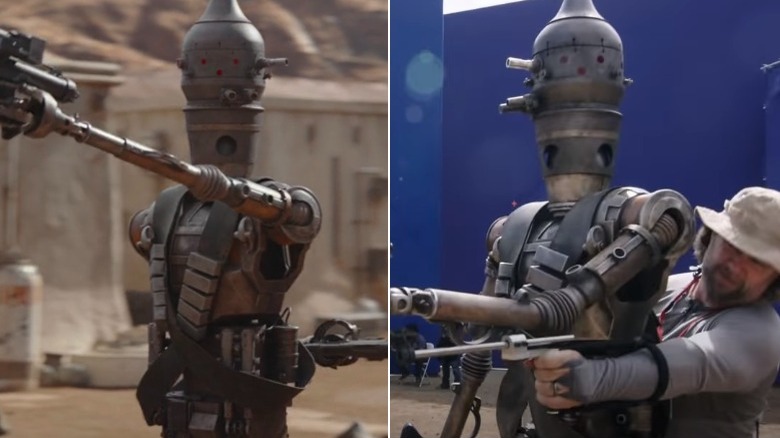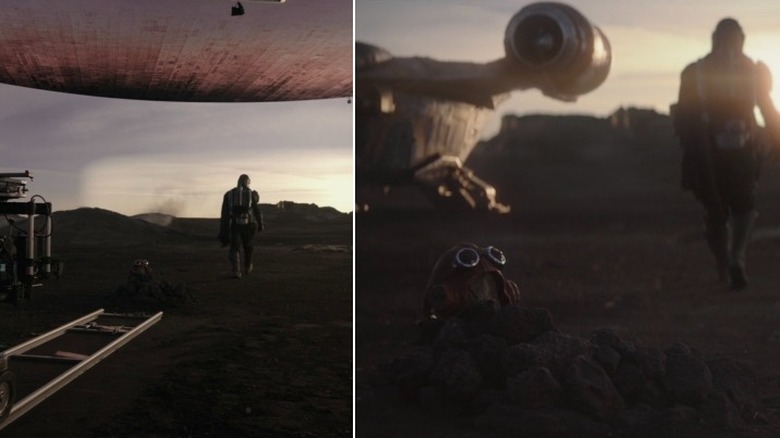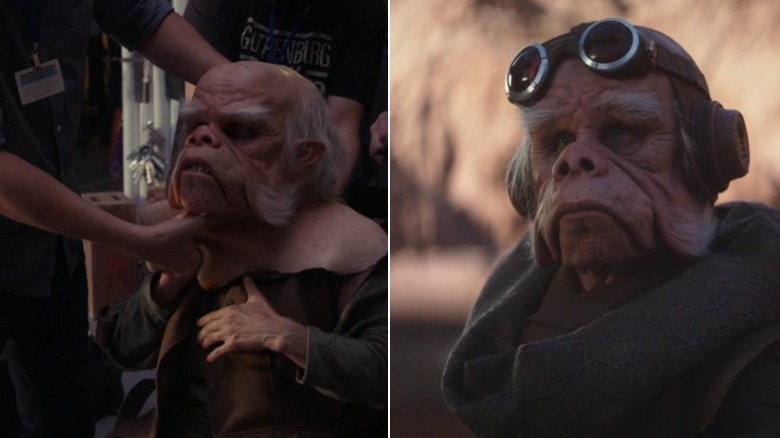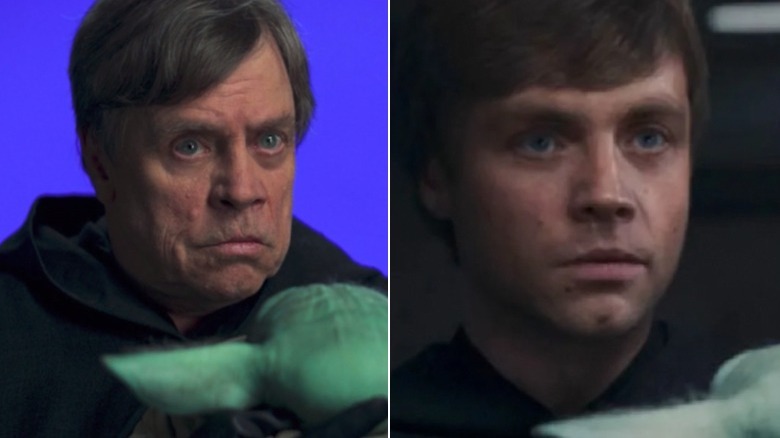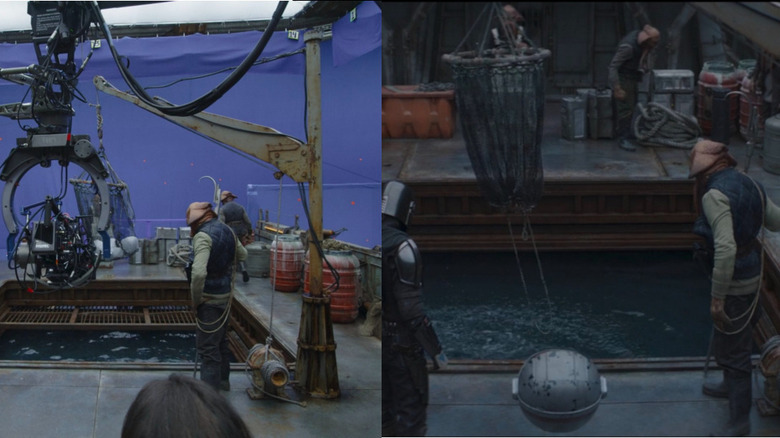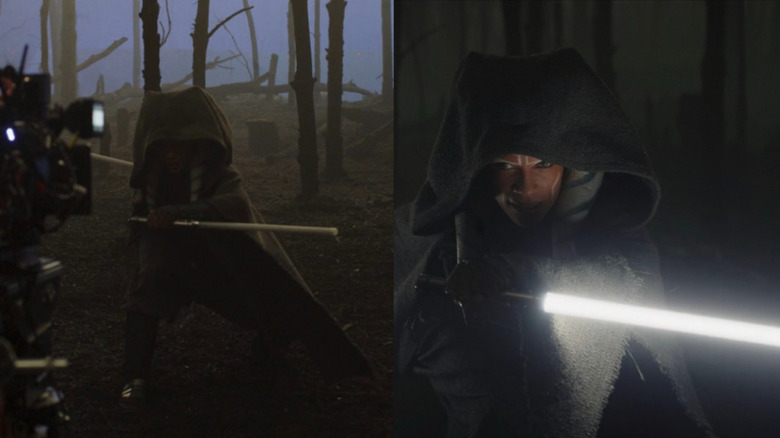What These Mandalorian Scenes Look Like With No Special Effects
When Lucasfilm and Disney+ released "The Mandalorian" in November 2019, it was a resounding overnight success. Created by Jon Favreau and Dave Filoni, "The Mandalorian" follows the journey of Pedro Pascal's Din Djarin (otherwise known as the Mandalorian or Mando), a bounty hunter who unexpectedly develops a father-son relationship with the tiny, Force-sensitive Grogu.
This spinoff series has pushed the boundaries of the "Star Wars" universe in ways that previous projects were unable to do, especially when it comes to special effects — from its prosthetic masks and miniature spaceship models to establishing new methods of special effects that have raised the bar for future TV shows and movies. Of course, behind the camera, the before and after differences are astounding. The special effects wizards make it look like Mando is exploring new planets when Pedro Pascal is really surrounded by LED sets, impressive animatronics have made alien characters and robots come to life (we all really wanted Baby Yoda to be real), and while the lightsaber props aren't quite as cool as their on-screen counterparts, they definitely look more realistic than ever before.
So if you're wondering what the world of Din Djarin and Grogu actually looks like, here are some of our favorite scenes from "The Mandalorian" before and after all the special effects tech.
The land creatures
With every installment in the "Star Wars" empire, we see newly designed creatures from far-off planets that only the most creative minds could think of. Even in the first few episodes of "The Mandalorian," some of these fictitious animals play a vital role in making the "Star Wars" world truly come alive. Take the Blurrgs, for instance. These fat, bipedal, possibly reptilian creatures have been seen running around on Arvala-7, a planet on where Din Djarin finds himself during one of his missions. Our titular bounty hunter uses these creatures to get around, and while speeders or pods may be an easy choice for a film crew to work with, where exactly is the fun in playing that old record again and again?
Pixomondo's visual effects supervisor Goran Backman explained to DigitalTrends some of the challenges they had to overcome to make these look as realistic as possible, saying, "Since we had a lot of interaction between the actors and the creatures, we also had to drive the on-set, practical buck — that's what we called the saddle that the actors would ride, sort of like the seat on a mechanical bull." The actors' riding motions were captured thanks to the work of mechanical pistons at the base of the practical Blurrgs. From there, special effects teams would work post-filming to create the Blurrgs' remaining body, stationary, and in-motion poses. Interestingly, the Pixomondo team often referenced rhinos and elephants for some of the Blurrgs' features.
Baby Yoda
Ah, yes. Little Grogu — or more lovingly known as Baby Yoda — is arguably "The Mandalorian's" true star. When Disney's spinoff show aired in 2019, Baby Yoda dominated the Internet's meme-sphere for months. Grogu spends his time on the show trailing after Din as the two venture around the Outer Rim. A majority of the time, we see Grogu sitting comfy in his floating egg-shaped pram, but whether the little dude is in his bed, up walking around, or sipping some tea, it takes an entire team to make Baby Yoda the meme master we all know and love.
This tiny alien was created thanks to the combined efforts of animatronics and CGI technology. According to "Disney Gallery: The Mandalorian," it took three months to develop and build the Grogu seen on the screen. Behind the camera, it took one person each from Legacy Effects to puppeteer the arms, eyes, body, head, ears, and walking movements. The use of CGI only came into play to remove the wires and poles used to control Grogu out of shots.
Director Bryce Dallas Howard made a particular point in support of animatronic creatures over using all CGI tech. She said during a "Disney Gallery" episode that there is a special magic that comes from using a moveable prop instead of solely going with CGI. The actors' reactions to seeing Baby Yoda were authentic, and the physical acting and movements with Grogu were far more real and being captured in real-time.
The Razor Crest
The minds behind "The Mandalorian" have been widely praised for their unique ways of bringing this sci-fi world to life. For example, ILM (Industrial Light & Magic) released a short documentary breaking down the construction of Din's spaceship, the Razor Crest. And here, we see that instead of crafting the Razor Crest with computer graphics, visual effects creators from ILM went to work on miniature models of the spacecraft.
3D printers were used to build the Razor Crest piece by piece. From there, John Goodson, the physical model maker from ILM, put the individual pieces together, added the ship's exterior layers, took care of the fine paint details, and voilà! The Razor Crest was ready to fly. In order to get the ship to the big screen, a specially designed camera rig would film the model. As the ship sat in one spot with surrounding blue screen, the rigged camera would fly past, and to give the craft more movement, techs would wobble the model from side to side. This technique of filming a model was a bit of an homage to the original trilogy, as practical miniature ships like the Millennium Falcon, TIE fighters, and X-Wings were built and shot in front of blue screens and then later added to starry backgrounds.
The Darksaber
The use of a Darksaber by the villainous Moff Gideon (Giancarlo Esposito) posed a unique challenge to prop designers of the show. Prop sabers were continuously being redesigned and built in order to get Gideon's weapon to look as accurate as possible. Unlike standard lightsabers and weapons that have been seen in the franchise before "The Mandalorian," the Darksabers' history had only ever been mentioned in "The Clone Wars" and "Star Wars: Rebels" (via CBR.com), and it had only appeared as a cartoon instead of in a physical form.
As a result, Hal Hickel, "The Mandalorian's" animation supervisor, commented during "Disney Gallery: The Mandalorian" that this new weapon "was enormously difficult to get right." He went on to add, "There was a lot of time put into getting the energy effect just right, that you see along the blade." The physical prop that was used during filming was lit to give the surrounding area the lighting effect that would normally come through from using a lighted weapon. The rest of the warbling effects that are seen during the final battle scene were the result of many hours of digital rendering.
Of course, lesser showrunners might have backed down from using something of the Darksaber's caliber. But leave it to the special effects team of "The Mandalorian" to rise to the challenge and create an actual physical sword that "Star Wars" fans have been wanting to see in live-action for a long time.
IG-11
One would think that with greater technological advances in filmmaking, robotics would look near perfect to humans. While that may be true to an extent, utilizing that technology to the opposite effect is a technique perfect for the "Star Wars" universe.
When it came time to bring IG-11 (voiced by Taika Waititi) to life as a robotic bounty hunter, visual effects animator Hal Hickel notes the distinct differences between this robot and a robot like K-2SO from "Rogue One" (voiced by Alan Tudyk). K-2SO was designed to be as close to human as a robot could get, and Hickel explains, by using motion capture suits, those smoother motions were easily achieved. But in the case of IG-11, the special effects team resisted the use of motion capture and instead used a prebuilt statue-like structure that had intentional awkwardness in the movements.
While there were a few parts, like the head, that could be moved remotely from a distance, the rest of the body had to be manually arranged behind the scenes, giving IG-11 a "rickety" effect, as explained by visual effects supervisor Richard Bluff during "Disney Gallery: The Mandalorian" interviews. This created an older, more rugged look that is perfect for a space Western.
Tech sets and landscapes
"The Mandalorian" creator Jon Favreau is never one to shy away from a cinematic challenge. According to "Disney Gallery," Favreau learned valuable lessons in behind-the-scenes technology during his time of "The Jungle Book" in 2016 and "The Lion King" in 2019. Many of the problems encountered during production of those previous productions came from the use of excessive blue and green screens and the lack of interactive sets around real-life actors. The solution? Invent revolutionary set technology.
During discussions with showrunners, Favreau broke down the techniques that were incorporated to Disney's successful "Star Wars" spinoff. He explains, "'The Mandalorian' is the first production ever to use real-time rendering and video wall in-camera, set extensions, and effects. That was, again, necessity was the mother of invention because we were trying to figure out how to do the production here in the timeframe, at the budget level, but still get the whole look we're used to seeing."
Massive LED screens projected the scene's background to create the effect that actors and camera crews were filming at outdoor locations. Director of photography Baz Idoine described how this interactive set worked. By utilizing positional data from cameras, the high-tech backgrounds can change as the camera moves. The result creates perspective or parallax (which can be defined as when an object appears slightly different from two different angles of view), giving viewers a more realistic feeling of being outside and allowing actors to feel like they are actually in a far-off world — something traditional green/blue screens can't do.
Combining prosthetics and animatronics
Practical effects were a critical part of creating this universe. Animatronic puppets like Baby Yoda can be controlled from a distance. Robots like IG-11 are controlled with remotes and can be walked around using frames and wheels. But while these techniques are effective to an extent, one could argue that lacking an actor behind a mask takes away some of the personality and humanity of certain characters.
A solution that has been used to remedy this is the use of animatronic prosthetics. Director Rick Famuyiwa says during interviews from "Disney Gallery: The Mandalorian" that this combination of humanity and technology is the "perfect marriage" that makes "Star Wars" what it is, explaining, "One part doesn't dominate the other. Doesn't feel like the technology is overwhelming, it doesn't feel like, 'Well, that's quaint and primitive, so I'm not buying it.'"
Take the character Kuiil, an Ugnaught voiced by Nick Nolte and played by Misty Rosas. According to creators who developed these prosthetics (via "Disney Gallery: The Mandalorian"), Rosas' ability as an actor gave Kuiil the mobility that allowed the character a softer and more relatable persona while the animatronic mask created a face that viewers hadn't seen since "The Empire Strikes Back." Similar combinations of animatronic prosthetics and actors were seen again with the Frog Lady in Season 2. Viewers were able to see a unique blend of humanity and alien emotion that wouldn't otherwise be achievable exclusively one way or the other.
Luke Skywalker
When showrunner Jon Favreau broke the news of Luke Skywalker's appearance in "The Mandalorian" for the Season 2 finale, the atmosphere on set changed drastically, according to interviews with director Petyon Reed (via "Disney Gallery"). In addition to the character making his entrance to the series, Mark Hamill himself would also be involved. According to IndieWire's conversation with VFX supervisor Richard Bluff, Hamill showed up on the set, in costume, which allowed the filmmakers to use his actual likeness and to get his thoughts on the performance of the character.
Additionally, according to "Disney Gallery" interviews with Hamill, Favreau and director Dave Filoni proposed using a techy de-aging process once Hamill filmed his parts on set. The de-aging process that best suited the needs of "The Mandalorian" was to replace Hamill's real face with an AI-generated image of his younger face using a legit version of a deepfake program. In order to create this younger face, art director Landis Fields took 4K footage from all three original "Star Wars" films, interviews of Hamill from the same time period, and still photographs from set to compile what Favreau calls the "library of faces" (via "Disney Gallery").
With thousands of images of Luke from the era of the original trilogy, the deepfake program's AI would have a chance to rebuild expressions and match facial characteristics and specific movements that line up with Hamill's lines in "The Mandalorian." Of course, Hamill wasn't the only one playing Luke, as his body movements were performed by double Max Lloyd-Jones. With the help of Hamill, Lloyd-Jones, and some amazing tech, Luke Skywalker was able to make his grand entrance and help the save the day.
Unique planets
A major goal of "The Mandalorian" showrunners has been to give audiences more than a simple illusion of reality. When it comes to filming varying geographies of foreign planets, creators of the series have taken it upon themselves to film as though they're actually in unfamiliar conditions. For example, when it came time to create the planet of Trask in Season 2, director Bryce Dallas Howard explained the process in "Disney Gallery," saying, "You can't just say, 'The vision effects will make it look real.' You want to shoot it in a manner in which you would actually have to shoot it if it was real. And then the audience believes that it's real."
Of course, digital special effects, CGI, and other combined computerized renderings are the cherries that top the cake. But in order to achieve the look that made up most of the boat scenes in this episode, a massive set was built to replicate the ship's deck. The challenge, according to special effects crew (via "Disney Gallery"), was making a static boat stage look like a moving ship. Of course, with the use of those fancy LED landscape screens and the ability to alter parallax views, as well as specialized camera movements and CGI additions, the boat set itself never had to actually move.
Lightsabers
True lightsaber visuals have always been a special effects feature exclusively isolated to "Star Wars." Even so, the lightsaber's inclusion in "The Mandalorian" is special. In the same way that Moff Gideon's Darksaber made its first physical appearance on the series, Ahsoka Tano's (Rosario Dawson) twin white blades made their live-action debut as well.
Being able to capture actual light from props was a relatively new way to film lightsabers when "The Mandalorian" was filmed. According to Richard Bluff (via "Disney Gallery"), to get the right effect of lightsabers during filming, a visual technique known as interactive lighting was used. This process of interactive lighting used LED lights built into the base of prop sabers, which allowed the camera to capture how sabers would project real light and shadows on and around the actors without obscuring the camera's field of vision with light distortion. From there, cinematographers were easily able to frame the camera on specific focal points based on where the interactive lighting from the prop lightsabers were highlighting character features.
Without the light source in the props, early film lightsabers didn't cast light or shadows. This was noticeable by the lack of lightsaber glow reflected on actors' faces. Sabers from the original "Star Wars" film trilogy got their glow effect from reflective tape on the props (via The Verge). Colors and other effects were added to individual frames in post-production using a technique known as rotoscoping technology. Compare that to "The Mandalorian," and it just shows how far the worlds of special effects and "Star Wars" have come.
